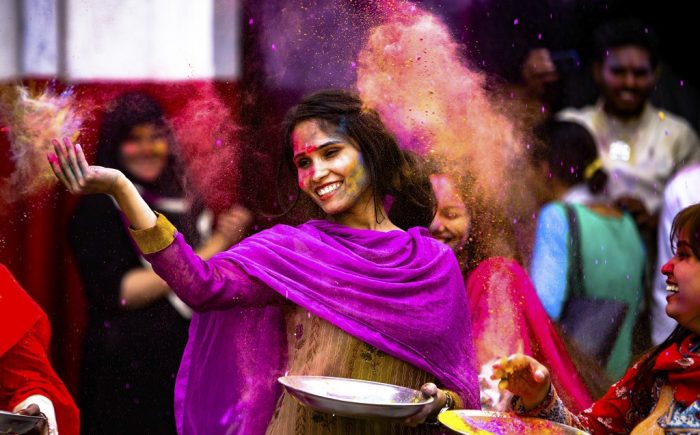India is a land of great diversity. It described as a land of many religions and innumerable languages, it might well be described as a land of festivals as well. Indians love celebrating. Every little occasion from the harvesting of crops, welcoming the spring or rain, to seeing the full moon lends itself to joyous celebrations splashed with colors, music, folk dances and songs. Even the birthdays of divine beings are celebrated by connecting them with particular festivals.
The Indian calendar is one long procession of festivals. These are as varied in origin as they are large in number. India is a multilingual, multi-religious, multi-cultural nation.
With a multitude of religions and important festivals celebrated on a common land by the people of different communities, the people of India celebrate each festival with great pride and oneness, thus showcasing the integrity among all the fellow Indians.
Indian festivals are celebrated according to the solar and lunar calendars. Consequently, dates & months may vary accordingly.
Diwali
Diwali is an important festival, because on this day Mahavira is supposed to have attained nirvana. Jain’s tends to avoid firecrackers during Diwali as they causes noise pollution. Diwali is celebrated in atmosphere of austerity, simplicity, serenity, equity, calmness, charity, philanthropy and environment-consciousness. Jain temples, homes, offices, shops are decorated with lights and diyas. Relatives distributes sweets to each other. The lights are symbolic of knowledge or removal of ignorance. Swetambar Jain’s observe three days of fasting in remembrance of the penance and sacrifice of Mahavira. In temples and homes, devotees sing and chant hymns and mantras from Jain religious texts in praise of the Tirthankar and congregate for a prayer and recite verses from the Uttaradhyayan Sutra which contain the last teachings of Mahavira. Jain pay visit to Pava-puri on this special day to offer their prayers. The Jain year starts with pratipada, next day of Diwali. Diwali is also important for Jain’s as it marks the beginning of their new year. All business accounts of the previous year are settled and new account books are started. On this day businessmen go to shops and buy new account books and worship them along with the image of Lakshmi as well as currency notes, jewelery, etc. at a special ceremony.
Holi
Holi is also called the Spring Festival – as it marks the arrival of spring the season of hope and joy. The gloom of the winter goes as Holi promises of bright summer days. Nature too, it seems rejoices at the arrival of Holi and wears its best clothes. Fields get filled with crops promising a good harvest to the farmers and flowers bloom colouring the surroundings and filling fragrance in the air. Holi festival may be celebrated with various names and people of different states might be following different traditions. But, what makes Holi so unique and special is the spirit of it which remains the same throughout the country and even across the globe, wherever it is celebrated.
Onam
Onam Festival falls during the Malayalam month of Chingam (Aug – Sep) and marks the commemoration of Vamana avatara of Vishnu and the subsequent homecoming of King Mahabali. Onam is reminiscent of Kerala’s agrarian past, as it is considered to be a harvest festival.
The festival falls during the Malayalam month of Chingam (Aug – Sep) and marks the homecoming of the mythical King Mahabali who Malayalees consider as their King. It is one of the festivals celebrated with most number of cultural elements. Some of them are Vallam Kali, Pulikkali, Pookkalam, Onatthappan, Thumbi Thullal, Onavillu, Kazhchakkula, Onapottan, Atthachamayam etc.
Onam is an ancient festival which still survives in modern times. Kerala’s rice harvest festival and the Festival of Rain Flowers, which fall on the Malayalam month of Chingam, celebrates the Asura King Mahabali’s annual visit from Patala (the underworld). Onam is unique since Mahabali has been revered by the people of Kerala since prehistory.The King is so much attached to his kingdom that it is believed that he comes annually from the nether world to see his people living happily. It is in honour of King Mahabali that Onam is celebrated. The deity Vamana, also called Onatthappan, is also revered during this time by installing a clay figure next to the floral carpet (Pookalam) .The birthday of Sri Padmanabhan, the presiding Deity of Thiruvananthapuram, is on the Thiruvonam day in the month of Chingam.
Ganesh chathurthi
Traditional Ganesha Hindu stories tell that Lord Ganesha,son of goddess Parvati consort of Shiva. Parvati created Ganesha out of sandalwood paste that she used for her bath and breathed life into the figure. She then set him to stand guard at her door while she bathed. Lord Shiva, who had gone out, returned and as Ganesha didn’t know him, didn’t allow him to enter. Lord Shiva became enraged by this and asked his follower Ganas to teach the child some manners. Ganesha who was very powerful, being born of Parvati, the embodiment of Shakti, defeated Shiva’s followers and declared that nobody was allowed to enter while his mother was bathing. The sage of heavens, Narada along with the Saptarishis sensed the growing turmoil and went to appease the boy with no results. Angered, the king of Gods, Indra attacked the boy with his entire heavenly army but even they didn’t stand a chance. By then, this issue had become a matter of pride for Parvati and Shiva. Angry Shiva severed the head of the child. Parvati seeing this became enraged. Seeing Parvati in anger Shiva promised that her son will be alive again. The devas searched for the head of dead person facing North, but they found only the head of a dead elephant. They brought the head of the elephant and Shiva fixed it on the child’s body and brought him back to life. Lord Shiva also declared that from this day the boy would be called Ganesha (Gana Isha : Lord of Ganas).According to the Linga Purana, Ganesha was created by Lord Shiva and Goddess Parvati at the request of the Devas for being a Vighnakartaa (obstacle-creator) in the path of Rakshasas, and a Vighnahartaa (obstacle-averter) to help the Devas achieve fruits of their hard work.
Ganesha Chaturthi is the Hindu festival celebrated on the birthday (rebirth) of the lord Ganesha, the son of Shiva and Parvati.It is believed that Lord Ganesh bestows his presence on earth for all his devotees during this festival. It is the day when Ganesha was born. Ganesha is widely worshiped as the god of wisdom, prosperity and good fortune and traditionally invoked at the beginning of any new venture or at the start of travel. The festival, also known as Vinayaka Chaturthi (“festival of Ganesha”) is observed in the Hindu calendar month of Bhaadrapada, starting on the shukla chaturthi (fourth day of the waxing moon period). The date usually falls between 19 August and 20 September. The festival lasts for 10 days, ending on Anant Chaturdashi (fourteenth day of the waxing moon period).
Merry Christmas
While the birth year of Jesus is estimated among modern historians to have been between 7 and 2 BC, the exact month and day of his birth are unknown. His birth is mentioned in two of the four canonical gospels. By the early-to-mid 4th century, the Western Christian Church had placed Christmas on December 25,a date later adopted in the East, although some churches celebrate on the December 25 of the older Julian calendar, which corresponds to January in the modern-day Gregorian calendar. The date of Christmas may have initially been chosen to correspond with the day exactly nine months after early Christians believed Jesus to have been conceived, or with one or more ancient polytheistic festivals that occurred near southern solstice (i.e., the Roman winter solstice); a further solar connection has been suggested because of a biblical verse identifying Jesus as the “Sun of righteousness”.
The celebratory customs associated in various countries with Christmas have a mix of pagan, pre-Christian, Christian, and secular themes and origins. Popular modern customs of the holiday include gift giving, Christmas music and caroling, an exchange of Christmas cards, church celebrations, a special meal, and the display of various Christmas decorations, including Christmas trees, Christmas lights, nativity scenes, garlands, wreaths, mistletoe, and holly. In addition, several closely related and often interchangeable figures, known as Santa Claus, Father Christmas, Saint Nicholas, and Christkind, are associated with bringing gifts to children during the Christmas season and have their own body of traditions and lore. Because gift-giving and many other aspects of the Christmas festival involve heightened economic activity among both Christians and non-Christians, the holiday has become a significant event and a key sales period for retailers and businesses. The economic impact of Christmas is a factor that has grown steadily over the past few centuries in many regions of the world.


 Share on bsky
Share on bsky





Read 0 comments and reply